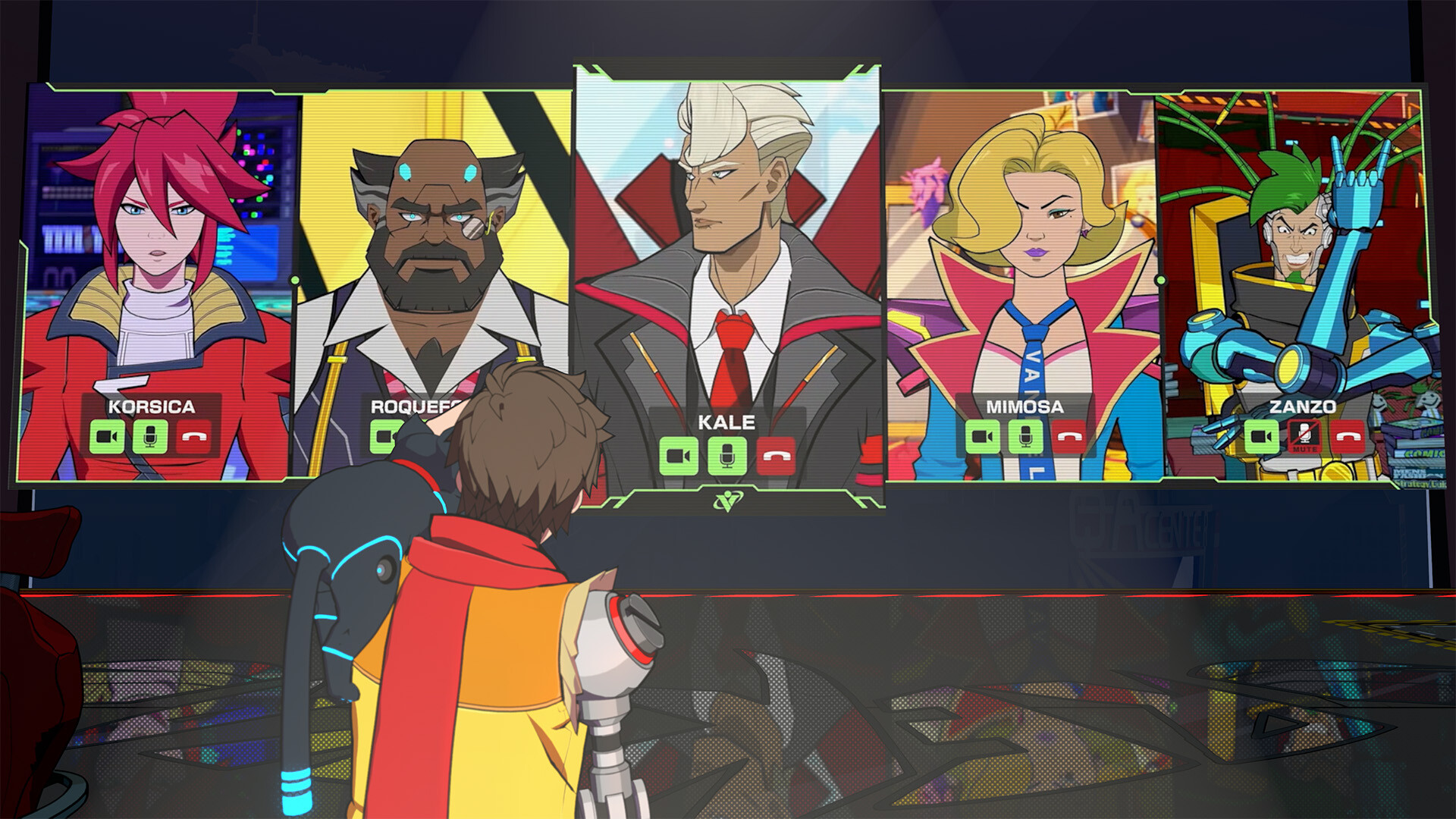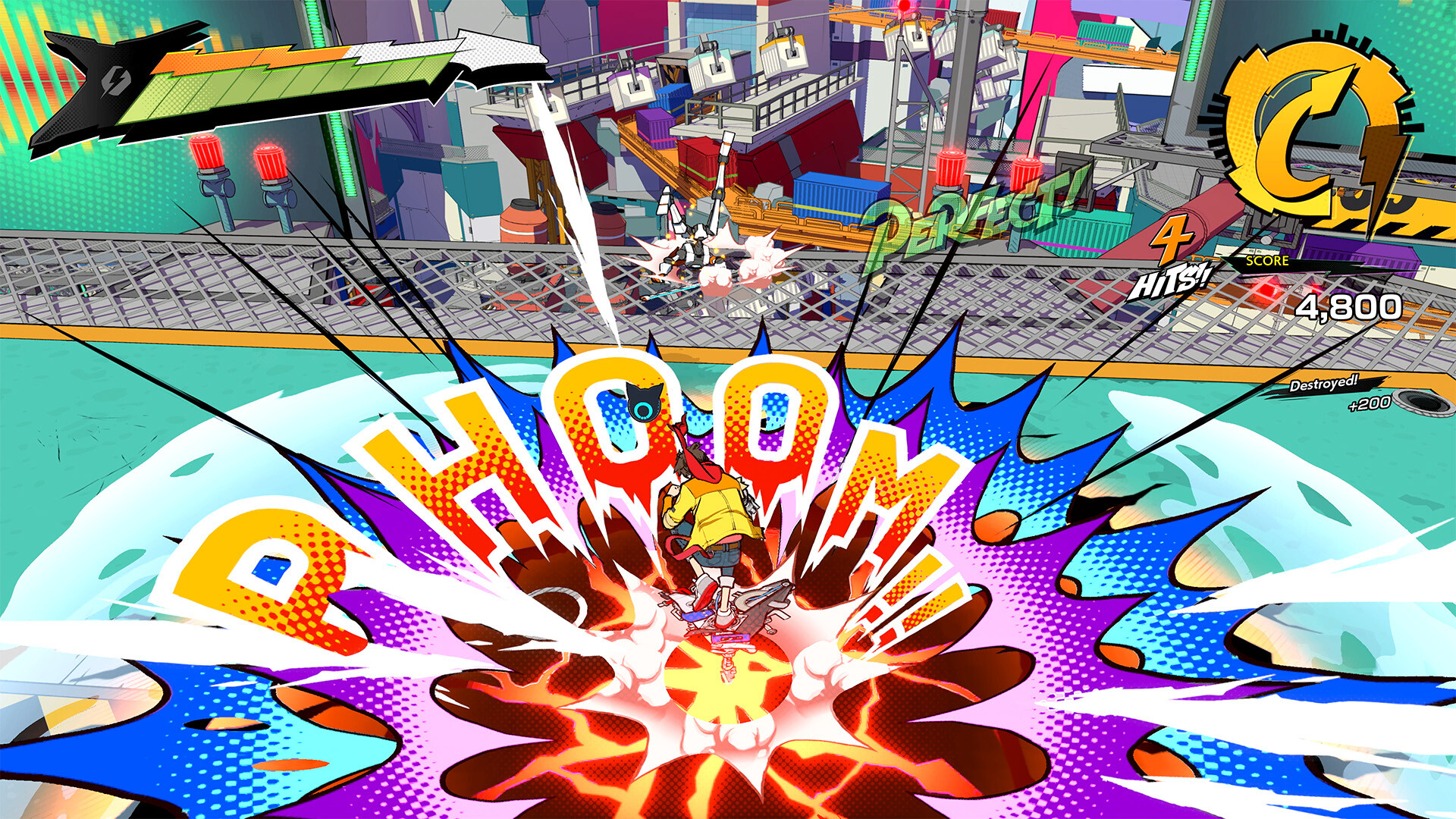Hi-Fi RUSH probably shouldn’t exist, and it definitely shouldn’t be as good as it is. But this rhythm action game from Tango Gameworks is a blast from the jump, a rollicking love letter to color and music and an era when games had things to say but didn’t take themselves too seriously. I was in love with it almost immediately.
Hi-Fi RUSH is the story of Chai, a music-obsessed young man named after tea who dreams of being a rockstar. His right arm is disabled, so he volunteers for Project Armstrong, a pilot program for replacing fleshy limbs with cybernetic ones. During the process, Chai’s iPod is accidentally fused to his cybernetic implant. He’s deemed a defect, and robotic goons are sent to hunt him down.
Fortunately for Chai, his robotic arm gives him the ability to summon a weapon (which looks suspiciously like a Gibson Flying V), and, as it turns out, having an iPod fused to your chest has its benefits. Everything in Hi-Fi RUSH syncs to the song playing on Chai’s iPod. Enemies attack you on beat. The world pulses with the beat. Environmental hazards change with the beat.
Chai’s attacks always land to the beat, too, but hits are more powerful, with greater knockback, if you time your button presses to hit on-time. Time your dashes right, and you’ll get more of them, too. Dealing damage further builds up a meter Chai can use to unleash special attacks, and it’s worth using whenever you can since that meter depletes at the end of each combat encounter.
Hi-Fi RUSH also scores you as you play, assigning points and a rating from D to S based on how well you perform. Clearing enemies quickly, avoiding damage, and nailing your timing increases your score, so it’s a good thing to learn quickly, especially if you’re after high scores. Killing enemies also drops gears, which can be used to upgrade Chai’s abilities, buy new combos, and acquire new special attacks.
Nailing a perfectly-timed combo and hearing a crowd roar feels fantastic, and getting to add a few notes to the soundtrack yourself is a pretty great feeling, even if you’re just fighting regular enemies. Hi-Fi RUSH is also kind enough to just let you play how you want; you can turn off the meter tracking the beat, so there’s no drawback if you don’t have a ton of rhythm initially. Just keep going, and you’ll pick it up eventually.
Between combat encounters, you’ll hop and jump through the world performing basic platforming, play the odd rhythm mini-game, explore Hi-Fi RUSH‘s world, and grabbing collectibles and power-ups. Levels are linear, but they’re a blast to play around in. Like in combat, landing jumps and dashes in rhythm allows you to go higher and farther; plus, it’s just plain fun.
Platforming is pretty basic, but because everything in the world moves to the beat, that, too, quickly turns into a rhythm game. Being on beat so you land on a platform before it falls or a moving part before it’s out of range means paying attention and being precise instead of just going through the rote motions.
To say Hi–Fi RUSH is visually striking is an understatement. Everything is beautifully cel-shaded, lovingly animated, and electrically rhythmic, jumping with every musical note. Hi-Fi RUSH‘s world is so vibrant and colorful that it’s hard not to get caught up in it. It helps that the characters are so endearing.
Chai, robo-cat companion 808, and partner Peppermint, are just plain fun. Chai is a likeable goofball that tends to dive headfirst into trouble; it’s hard not to root for him. 808 is adorable, and Peppermint often keeps Chai in check, which is a good thing. Their dynamic is playful and infectious, and I enjoyed spending every minute with them.
Hi-Fi RUSH is funny, too. Whether it’s a visual gag where a robot laments his life after dropping a stack of boxes, Chai flying through a wall in a fashion that evokes classic Looney Tunes, or one of the hilarious collectibles scattered throughout the game, Hi-Fi RUSH is always laugh-out-loud entertaining.
I had a smile on my face the whole time I was playing, and any game that so effortlessly nails such a feeling of joy is something pretty special.
Hi-Fi RUSH may be silly, but it also has some surprisingly biting critiques about corporations and capitalism under the hood. Announcements about workers having to schedule sick days six months in advance or obsolete robots getting recycled before they can even say goodbye to their friends feel depressingly modern, and having the guts to portray that, even in an otherwise fairly lighthearted game, is pretty rare.
H-Fi-Rush Review — The Bottom Line
Pros
- Incredible visual and sound design.
- Interesting story and characters.
- Accessibility options to help you stay on rhythm .
- Extremely funny.
Cons
- You have to finish the game to replay a stage.
- There could be more licensed tracks.
- Audio/video lag can really mess with the experience.
As you’d expect, Hi-Fi RUSH‘s soundtrack is fantastic, from the original songs that pepper most of the game’s levels to the licensed stuff that ranges from Nine Inch Nails to The Prodigy and The Black Keys. The cherry is that the music is always perfect for whatever you’re doing, and Hi-Fi RUSH cranks it up when it matters. Beating the brakes off a giant, evil QA robot while Nine Inch Nail’s “1,000,000” plays in the background is something I can’t ever imagine getting old.
And at the end of the day, I can’t imagine any of Hi-Fi RUSH getting old. It’s so vibrant, so full of life, and so unique. It stands out in a world where many AAA releases seem determined to be anything but. Add in the replay value of chasing high scores and Rhythm Tower, which functions a lot like Devil May Cry‘s Bloody Palace mode, and this is a game that you can play for a long time.
Featured image via Bethesda










Published: Jan 31, 2023 09:06 pm